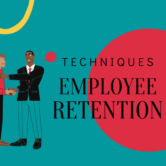Why Great Hiring Equals Strong Retention: Strategies That Work

In today’s competitive job market, companies are realizing that the key to retaining top talent starts long before an employee’s first day — it begins with hiring. While most organizations focus on retention strategies like employee engagement programs and rewards, the truth is that great hiring decisions form the foundation for long-term employee satisfaction and loyalty.
When you hire the right person — someone whose skills, values, and motivations align with your company culture — retention naturally improves. On the other hand, hiring the wrong person can lead to poor performance, low morale, and high turnover costs. In this blog, we’ll explore why great hiring leads to strong retention and outline actionable strategies that work in 2025 and beyond.
1. Understanding the Connection Between Hiring and Retention
Retention isn’t just about keeping employees — it’s about keeping the right employees. The hiring process sets the tone for an employee’s entire journey with your company. From the moment candidates interact with your brand, they begin forming impressions about your culture, communication, and values.
If those impressions are honest and aligned with the reality of your workplace, employees are more likely to feel satisfied and stay longer. However, when candidates are hired under false expectations — whether about job responsibilities, company culture, or career growth — dissatisfaction and disengagement soon follow.
In short: you can’t fix retention problems later if you don’t hire right from the start.
2. The Cost of Poor Hiring Decisions
The impact of a bad hire goes far beyond recruitment expenses. Studies show that replacing an employee can cost between 50% and 200% of their annual salary when you factor in hiring costs, training time, and productivity loss.
Poor hiring decisions can also affect team morale and company culture. When employees see high turnover or colleagues who don’t fit the culture, it reduces trust in leadership and engagement across the board.
This is why forward-thinking organizations are focusing on quality of hire as a key HR metric — because the better your hiring process, the stronger your retention outcomes.
3. Hiring for Cultural Fit and Growth Potential
Skills and experience matter, but they’re not everything. One of the biggest predictors of retention is cultural fit — hiring people whose values and working styles align with the company’s mission and team dynamics.
However, cultural fit doesn’t mean hiring people who all think alike. Instead, it’s about shared purpose and complementary strengths. A strong hiring process should assess how a candidate’s goals align with organizational values while also promoting diversity and inclusion.
Beyond fit, look for growth potential. Employees who see clear paths for advancement are more likely to stay. During interviews, ask about long-term goals and provide insight into career development opportunities. That conversation alone can spark loyalty before the employee even joins.
4. Building a Structured, Transparent Hiring Process
A disorganized hiring process creates confusion for candidates and inconsistency in decision-making. The best retention strategies start with structured and transparent hiring processes that ensure every candidate is evaluated fairly and effectively.
Here’s what that looks like in practice:
- Defined job descriptions: Clearly outline roles, expectations, and growth opportunities.
- Behavioral interviews: Use situational questions to assess problem-solving, adaptability, and teamwork.
- Collaborative evaluation: Involve multiple interviewers to reduce bias and ensure alignment on cultural fit.
- Transparent communication: Keep candidates informed throughout the hiring process to build trust from day one.
This level of professionalism and transparency signals that your organization values people — which attracts candidates who are likely to value you back.
5. Investing in Onboarding for Long-Term Success
Even the best hiring decision can fall flat without a strong onboarding program. The first few weeks shape an employee’s perception of your company and determine whether they feel supported and confident in their role.
Effective onboarding goes beyond paperwork. It should:
- Introduce employees to the company culture and core values
- Provide clear role expectations and success metrics
- Offer mentorship or peer support
- Include regular check-ins with managers
When employees feel prepared, connected, and valued early on, they’re far more likely to remain engaged — and stay longer.
6. Data-Driven Recruitment: Hiring Smarter, Retaining Longer
Technology and analytics now play a major role in improving both hiring and retention. Data-driven recruitment tools can identify which sources bring in the longest-tenured employees, which traits predict high performance, and which hiring practices reduce turnover.
For instance, predictive analytics can analyze patterns in successful hires to refine future recruitment strategies. Similarly, AI-powered tools can help HR teams assess candidate sentiment, engagement, and fit more accurately.
By making hiring decisions based on data instead of intuition, companies can reduce turnover and build stronger, more resilient teams.
7. Continuous Feedback and Employee Engagement
Hiring doesn’t end when the candidate accepts the offer — it transitions into engagement. A culture of feedback ensures that employees remain aligned, motivated, and satisfied.
Managers should regularly check in with new hires to ensure they have the tools and support they need. Early feedback can catch potential problems before they lead to disengagement or turnover.
Additionally, implementing employee engagement and retention programs such as recognition systems, wellness initiatives, and ongoing learning opportunities can significantly strengthen long-term commitment.
8. Leadership’s Role in Retention
Even with great hiring practices, poor leadership can undo retention efforts. Employees don’t leave jobs — they leave managers.
That’s why leadership development is an essential part of the hiring-retention equation. Great leaders know how to motivate, communicate, and build trust. They play a crucial role in ensuring that the values discussed during hiring continue to be lived out daily.
Organizations that invest in leadership coaching and management training consistently report higher engagement and lower turnover rates.
9. Building a Culture That Keeps the Right People
At its core, retention is about belonging. Employees stay when they feel seen, supported, and part of something meaningful.
Creating that sense of belonging starts with hiring individuals who resonate with your culture — and then reinforcing it through strong leadership, fair policies, and continuous growth opportunities.
When hiring and culture work hand-in-hand, retention becomes an outcome, not a struggle.
Conclusion: Hire Smart, Retain Strong
The link between great hiring and strong retention is undeniable. Every successful retention strategy begins with selecting the right people — those who share your values, believe in your mission, and see a future with your organization.
By investing in structured hiring processes, strong onboarding, leadership development, and data-driven decision-making, companies can build teams that not only perform well but also stay loyal for the long term.
In 2025, the organizations that thrive won’t be the ones hiring the fastest — they’ll be the ones hiring the smartest.










